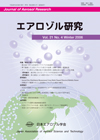Volume 22, Issue 2
Summer
Displaying 1-12 of 12 articles from this issue
- |<
- <
- 1
- >
- >|
Feature Articles -Planetary Aerosol-
-
2007 Volume 22 Issue 2 Pages 86
Published: June 20, 2007
Released on J-STAGE: June 20, 2007
Download PDF (534K) -
2007 Volume 22 Issue 2 Pages 87-94
Published: June 20, 2007
Released on J-STAGE: June 20, 2007
Download PDF (908K) -
2007 Volume 22 Issue 2 Pages 95-100
Published: June 20, 2007
Released on J-STAGE: June 20, 2007
Download PDF (807K) -
2007 Volume 22 Issue 2 Pages 101-106
Published: June 20, 2007
Released on J-STAGE: June 20, 2007
Download PDF (784K) -
2007 Volume 22 Issue 2 Pages 107-112
Published: June 20, 2007
Released on J-STAGE: June 20, 2007
Download PDF (749K) -
2007 Volume 22 Issue 2 Pages 113-118
Published: June 20, 2007
Released on J-STAGE: June 20, 2007
Download PDF (727K) -
2007 Volume 22 Issue 2 Pages 119-124
Published: June 20, 2007
Released on J-STAGE: June 20, 2007
Download PDF (776K) -
2007 Volume 22 Issue 2 Pages 125
Published: June 20, 2007
Released on J-STAGE: June 20, 2007
Download PDF (485K)
Research paper
-
2007 Volume 22 Issue 2 Pages 126-134
Published: June 20, 2007
Released on J-STAGE: June 20, 2007
Download PDF (1021K) -
2007 Volume 22 Issue 2 Pages 135-142
Published: June 20, 2007
Released on J-STAGE: June 20, 2007
Download PDF (534K)
Note
-
2007 Volume 22 Issue 2 Pages 143-146
Published: June 20, 2007
Released on J-STAGE: June 20, 2007
Download PDF (675K) -
2007 Volume 22 Issue 2 Pages 147-151
Published: June 20, 2007
Released on J-STAGE: June 20, 2007
Download PDF (542K)
- |<
- <
- 1
- >
- >|
